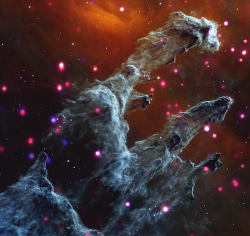 Reaching for the Stars
Reaching for the Stars
In the Milky Way and other galaxies, stars form within dense clouds composed largely of molecular hydrogen gas. Because these clouds are dense, trace elements like oxygen, carbon, silicon and iron can collide, stick together and form solid particles of dust. Dust plays an important role in star formation (and planet formation too), allowing molecular clouds to cool and gravitationally contract, letting lower-mass stars to form. But dust also hides the details of this important process from the view of curious scientists, since dust is very good at blocking optical light. But dust is not so good at blocking short wavelength, high energy X-rays, which can penetrate huge amounts of dust. Combining X-ray and infrared images of star forming clouds provides particularly important information on star formation, revealing the connection between the densest parts of a star forming cloud as traced by the infrared emission from heated dust and the young, active, X-ray emitting stars which form in these regions. This is especially true if you combine the high resolution X-ray images from the Chandra X-ray Observatory with the most sensitive, space-based infrared images from JWST. The image above shows a composite JWST-Chandra image of the famous "Pillars of Creation" in the Eagle Nebula star forming region. The Chandra X-ray image is shown in red and blue and is superimposed on the JWST image. This composite image shows how the young, flaring stars seen in X-rays affect their dusty natal environment.
CXC: Chandra, Webb Combine for Arresting Views
| << Previous HEAPOW | High Energy Astrophysics Picture of the Week | Next HEAPOW >> |